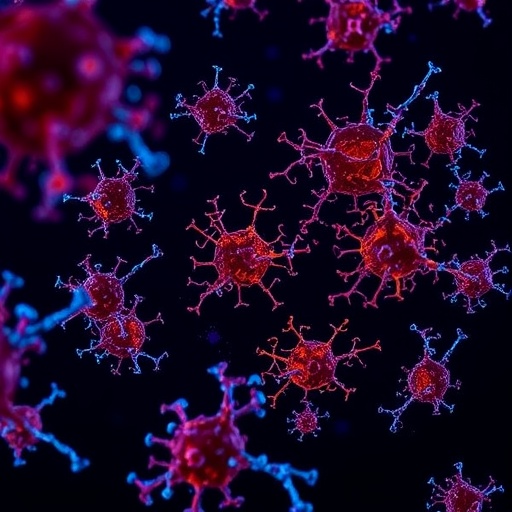In a groundbreaking study, scientists have unveiled the intricate mechanisms by which STING agonists induce death in monocytes, revealing multiple regulated cell death pathways activated concurrently. This cutting-edge research sheds light on the complex interplay between apoptosis, pyroptosis, caspase-8 activation, and mitochondrial dysfunction triggered by synthetic STING stimulators, highlighting their profound immunological ramifications.
Monocytes, a critical component of the innate immune system, serve as crucial sentinels against infection and cellular distress. This new research utilized primary human peripheral blood mononuclear cells (PBMCs) and enriched monocyte populations cultivated under standardized conditions, mimicking physiological environments closely. The scientists meticulously exposed these cells to a range of pathogen recognition receptor (PRR) agonists and distinct STING activators, such as diABZI, 3′,3′-c-di(2′F,2′d-AMP), and 2′,3′-cGAMP, to precisely delineate the cellular response cascade.
Advanced flow cytometry and immunophenotyping techniques were employed to track cellular responses post-treatment, including detection of active caspases, a hallmark of programmed cell death. Using FAM-FLICA kits and Caspase-Glo luminescence assays, researchers could quantify activation of caspase-1, caspase-3/7, caspase-8, and caspase-9, uncovering distinct patterns indicative of both apoptosis and pyroptosis. The simultaneous activation of these caspases underscores the multifaceted nature of death pathways induced by STING agonists.
Mitochondrial integrity emerged as a key determinant in STING-triggered monocyte death. Utilizing MitoSpy Orange CMTMRos and TMRM staining in flow cytometry allowed assessment of mitochondrial membrane potential, a sensitive indicator of mitochondrial health and function. STING agonist exposure led to significant mitochondrial dysfunction, corroborated by altered membrane potential and disruptions in mitochondrial dynamics. This mitochondrial impairment was closely linked with the observed activation of cell death pathways.
Furthermore, the study elegantly demonstrated that STING agonist-induced monocyte death involves the concurrent activation of multiple molecular players. Western blot analysis revealed cleavage of pro-caspase forms into their active equivalents and cleavage of gasdermin D (GSDMD), a pivotal effector of pyroptotic cell death. Intriguingly, phosphorylation and activation of receptor-interacting proteins RIP1, RIP3, and MLKL were also documented, implying involvement of necroptotic pathways, although pyroptosis and apoptosis were predominant.
A striking discovery involved the release of mitochondrial DNA (mtDNA) into the cytosol following STING activation. Quantitative PCR assays using mitochondrial COX2 gene primers highlighted significant mtDNA translocation from mitochondria to cytoplasm, signifying mitochondrial membrane compromise. This phenomenon potentially amplifies downstream immune signaling via the cGAS-STING axis and perpetuates inflammation, establishing a feedback loop driving monocyte demise.
Complementing the molecular analyses, high-resolution respirometry using the Oxygraph 2k system provided functional insights into mitochondrial respiration post-STING stimulation. The oxygen consumption profiles revealed impaired ATP-linked respiration and reduced spare respiratory capacity in monocytes treated with STING agonists, highlighting metabolic collapse as a contributor to cell death. These phenotypic metabolic shifts were further confirmed by Seahorse extracellular flux analyses, which monitored monocyte respiration and glycolytic flux in real time.
To validate the specificity of the pathways involved, chemical inhibition experiments targeting TBK1 kinase and caspase-1 demonstrated partial rescue of monocyte viability, emphasizing the orchestrated involvement of key signaling nodes in STING-induced death. The elaborate gating strategies developed for flow cytometry, alongside unbiased clustering and dimensionality reduction methodologies like UMAP and FlowSOM, allowed precise identification of affected myeloid subpopulations, refining our understanding of cellular heterogeneity in response to STING agonists.
Importantly, the use of multiple STING agonists with varying efficacies underscored a dose-dependent gradation in cell death, with concentrations chosen deliberately above EC50 thresholds to elicit robust pathway activation. Control treatments using well-known apoptosis and pyroptosis inducers, such as staurosporine and nigericin, respectively, provided comparative baselines reinforcing the unique poly-modal death signature induced by STING stimulation.
Overall, the findings present an unprecedented panoramic view of how STING agonists operate as potent modulators of monocyte fate. The simultaneous triggering of apoptosis, pyroptosis, and mitochondrial disintegration unveils potential therapeutic vulnerabilities exploitable in infectious diseases, cancer immunotherapy, and autoinflammatory disorders. This knowledge paves the way for designing next-generation immunomodulatory drugs that harness or mitigate these pathways with precision.
The implications of this research extend beyond immunology, touching on cell death biology and metabolic regulation. By unraveling the mitochondrial underpinnings of STING-driven death, the study highlights mitochondria not merely as energy factories but as central arbiters of immune cell survival. Future investigations spurred by this work may decipher additional crosstalk between mitochondrial resilience and innate immune signaling.
This comprehensive analysis also accentuates the importance of integrated, multidisciplinary approaches in contemporary biomedical research. Combining molecular biology, immunophenotyping, metabolic assays, and advanced biophysical methodologies has enabled a holistic characterization of monocyte responses, setting a high standards benchmark for studies of cellular pathophysiology.
In conclusion, this pioneering study elucidates the multifaceted mechanisms whereby STING agonists instigate monocyte death via apoptosis, pyroptosis, caspase-8 activation, and mitochondrial dysfunction. These insights contribute foundational knowledge to the field of innate immunity and lay the groundwork for therapeutic innovation targeting STING-related pathways.
Subject of Research: Mechanisms of monocyte cell death induced by STING agonists
Article Title: STING agonists trigger monocyte death via apoptosis, pyroptosis, caspase-8 activation and mitochondrial dysfunction
Article References:
Pimkova Polidarova, M., Plecita-Hlavata, L., Hirsch, I. et al. STING agonists trigger monocyte death via apoptosis, pyroptosis, caspase-8 activation and mitochondrial dysfunction. Cell Death Discov. 11, 494 (2025). https://doi.org/10.1038/s41420-025-02786-1
Image Credits: AI Generated
DOI: https://doi.org/10.1038/s41420-025-02786-1
Tags: advanced flow cytometry techniquesapoptosis and pyroptosiscaspase activation in immunologyimmunophenotyping in cell biologyinnate immune system researchmitochondrial dysfunction in immune responsemonocyte death mechanismspathogen recognition receptor agonistsprimary human peripheral blood mononuclear cellsregulated cell death pathwaysSTING agonistssynthetic STING stimulators





